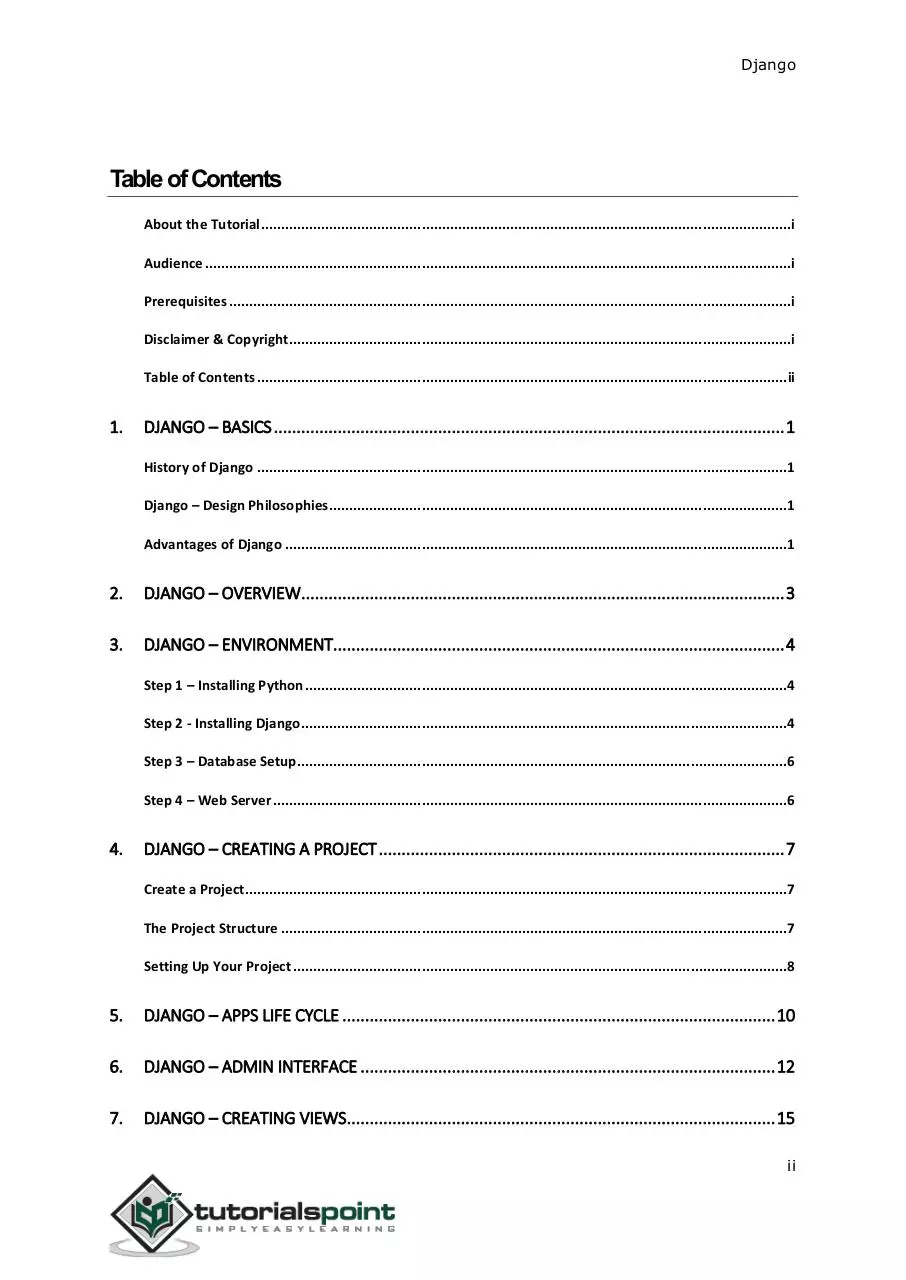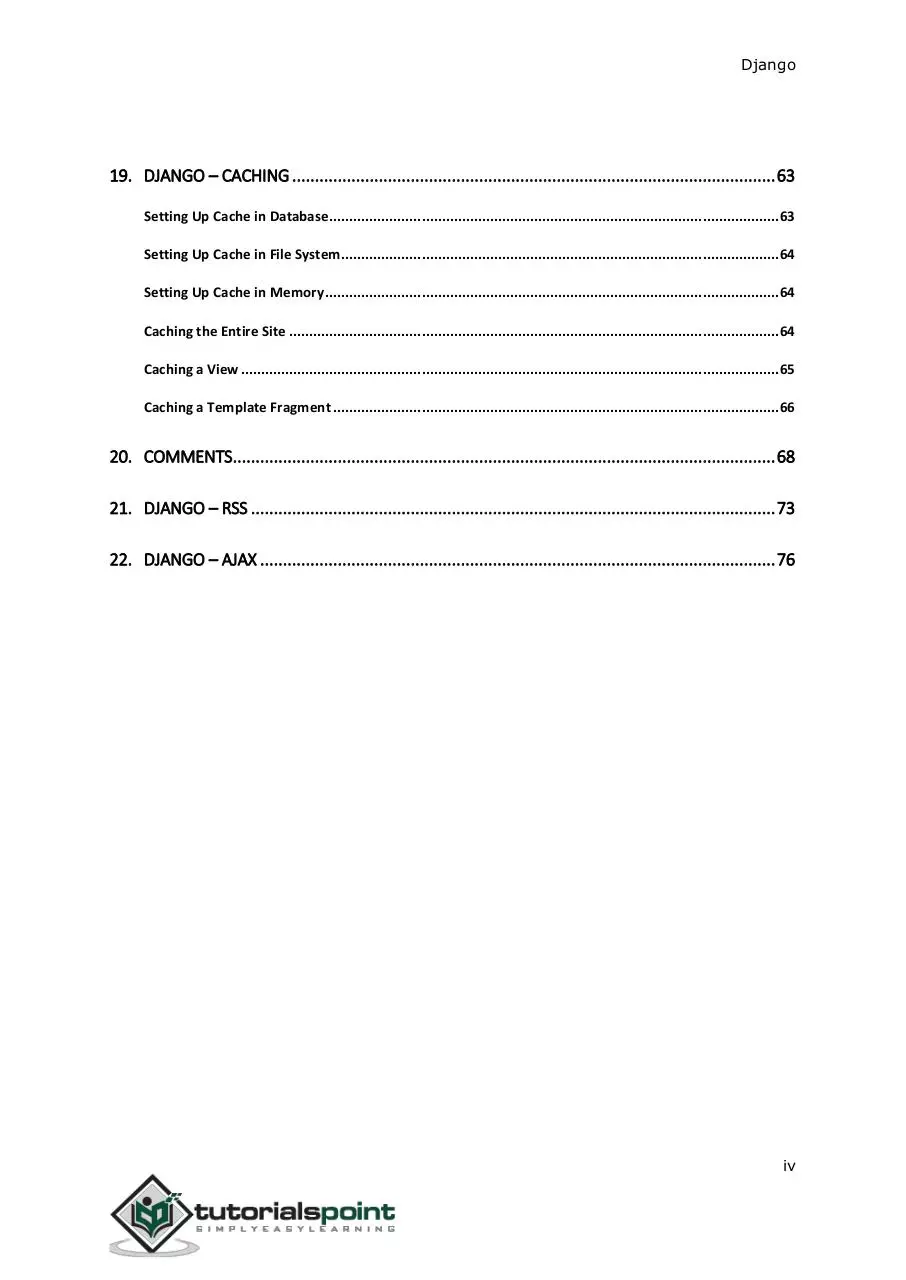django tutorial (PDF)
File information
Author: Priya Sen
This PDF 1.5 document has been generated by Microsoft® Word 2013, and has been sent on pdf-archive.com on 10/02/2018 at 00:43, from IP address 184.90.x.x.
The current document download page has been viewed 814 times.
File size: 1.87 MB (85 pages).
Privacy: public file





File preview
Django
About the Tutorial
Django is a web development framework that assists in building and maintaining quality
web applications. Django helps eliminate repetitive tasks making the development process
an easy and time saving experience. This tutorial gives a complete understanding of
Django.
Audience
This tutorial is designed for developers who want to learn how to develop quality web
applications using the smart techniques and tools offered by Django.
Prerequisites
Before you proceed, make sure that you understand the basics of procedural and objectoriented programming: control structures, data structures and variables, classes, objects,
etc.
Disclaimer & Copyright
Copyright 2015 by Tutorials Point (I) Pvt. Ltd.
All the content and graphics published in this e-book are the property of Tutorials Point (I)
Pvt. Ltd. The user of this e-book is prohibited to reuse, retain, copy, distribute or republish
any contents or a part of contents of this e-book in any manner without written consent
of the publisher.
We strive to update the contents of our website and tutorials as timely and as precisely as
possible, however, the contents may contain inaccuracies or errors. Tutorials Point (I) Pvt.
Ltd. provides no guarantee regarding the accuracy, timeliness or completeness of our
website or its contents including this tutorial. If you discover any errors on our website or
in this tutorial, please notify us at contact@tutorialspoint.com.
i
Django
Table of Contents
About the Tutorial .................................................................................................................................... i
Audience .................................................................................................................................................. i
Prerequisites ............................................................................................................................................ i
Disclaimer & Copyright............................................................................................................................. i
Table of Contents .................................................................................................................................... ii
1.
DJANGO – BASICS ................................................................................................................ 1
History of Django .................................................................................................................................... 1
Django – Design Philosophies .................................................................................................................. 1
Advantages of Django ............................................................................................................................. 1
2.
DJANGO – OVERVIEW.......................................................................................................... 3
3.
DJANGO – ENVIRONMENT................................................................................................... 4
Step 1 – Installing Python ........................................................................................................................ 4
Step 2 - Installing Django ......................................................................................................................... 4
Step 3 – Database Setup .......................................................................................................................... 6
Step 4 – Web Server ................................................................................................................................ 6
4.
DJANGO – CREATING A PROJECT ......................................................................................... 7
Create a Project....................................................................................................................................... 7
The Project Structure .............................................................................................................................. 7
Setting Up Your Project ........................................................................................................................... 8
5.
DJANGO – APPS LIFE CYCLE ............................................................................................... 10
6.
DJANGO – ADMIN INTERFACE ........................................................................................... 12
7.
DJANGO – CREATING VIEWS.............................................................................................. 15
ii
Django
8.
DJANGO – URL MAPPING .................................................................................................. 17
9.
DJANGO – TEMPLATE SYSTEM ........................................................................................... 23
The Render Function ............................................................................................................................. 23
Django Template Language (DTL) .......................................................................................................... 23
Filters .................................................................................................................................................... 24
Tags ....................................................................................................................................................... 24
10. DJANGO – MODELS ........................................................................................................... 28
Creating a Model ................................................................................................................................... 28
Linking Models ...................................................................................................................................... 30
11. DJANGO – PAGE REDIRECTION .......................................................................................... 33
12. SENDING E-MAILS.............................................................................................................. 36
Sending a Simple E-mail ........................................................................................................................ 36
Sending Multiple Mails with send_mass_mail ....................................................................................... 37
Sending HTML E-mail ............................................................................................................................ 39
Sending E-mail with Attachment ........................................................................................................... 41
13. DJANGO – GENERIC VIEWS ................................................................................................ 42
14. DJANGO – FORM PROCESSING .......................................................................................... 46
15. DJANGO – FILE UPLOADING .............................................................................................. 50
16. DJANGO – APACHE SETUP ................................................................................................. 54
17. DJANGO – COOKIES HANDLING ......................................................................................... 56
18. DJANGO – SESSIONS .......................................................................................................... 59
iii
Django
19. DJANGO – CACHING .......................................................................................................... 63
Setting Up Cache in Database ................................................................................................................ 63
Setting Up Cache in File System ............................................................................................................. 64
Setting Up Cache in Memory ................................................................................................................. 64
Caching the Entire Site .......................................................................................................................... 64
Caching a View ...................................................................................................................................... 65
Caching a Template Fragment ............................................................................................................... 66
20. COMMENTS....................................................................................................................... 68
21. DJANGO – RSS ................................................................................................................... 73
22. DJANGO – AJAX ................................................................................................................. 76
iv
1. Django – Basics
Django
Django is a high-level Python web framework that encourages rapid development and
clean, pragmatic design. Django makes it easier to build better web apps quickly and with
less code.
Note: Django is a registered trademark of the Django Software Foundation, and is licensed
under BSD License.
History of Django
2003: Started by Adrian Holovaty and Simon Willison as an internal project at the
Lawrence Journal-World newspaper.
2005: Released July 2005 and named it Django, after the jazz guitarist Django
Reinhardt.
2005: Mature enough to handle several high-traffic sites.
Current: Django is now an open source project with contributors across the world.
Django – Design Philosophies
Django comes with the following design philosophies:
Loosely Coupled: Django aims to make each element of its stack independent of
the others.
Less Coding: Less code so in turn a quick development.
Don't Repeat Yourself (DRY): Everything should be developed only in exactly
one place instead of repeating it again and again.
Fast Development: Django's philosophy is to do all it can to facilitate hyper-fast
development.
Clean Design: Django strictly maintains a clean design throughout its own code
and makes it easy to follow best web-development practices.
Advantages of Django
Here are few advantages of using Django which can be listed out here:
Object-Relational Mapping (ORM) Support: Django provides a bridge between
the data model and the database engine, and supports a large set of database
systems including MySQL, Oracle, Postgres, etc. Django also supports NoSQL
database through Django-nonrel fork. For now, the only NoSQL databases
supported are MongoDB and google app engine.
1
Django
Multilingual Support: Django supports multilingual websites through its built-in
internationalization system. So you can develop your website, which would support
multiple languages.
Framework Support: Django has built-in support for Ajax, RSS, Caching and
various other frameworks.
Administration GUI: Django provides a nice ready-to-use user interface for
administrative activities.
Development Environment: Django comes with a lightweight web server to
facilitate end-to-end application development and testing.
2
2. Django – Overview
Django
As you already know, Django is a Python web framework. And like most modern
framework, Django supports the MVC pattern. First let's see what is the Model-ViewController (MVC) pattern, and then we will look at Django’s specificity for the Model-ViewTemplate (MVT) pattern.
MVC Pattern
When talking about applications that provides UI (web or desktop), we usually talk about
MVC architecture. And as the name suggests, MVC pattern is based on three components:
Model, View, and Controller. Check our MVC tutorial here to know more.
DJANGO MVC - MVT Pattern
The Model-View-Template (MVT) is slightly different from MVC. In fact the main difference
between the two patterns is that Django itself takes care of the Controller part (Software
Code that controls the interactions between the Model and View), leaving us with the
template. The template is a HTML file mixed with Django Template Language (DTL).
The following diagram illustrates how each of the components of the MVT pattern interacts
with each other to serve a user request:
The developer provides the Model, the view and the template then just maps it to a URL
and Django does the magic to serve it to the user.
3
3. Django – Environment
Django
Django development environment consists of installing and setting up Python, Django,
and a Database System. Since Django deals with web application, it's worth mentioning
that you would need a web server setup as well.
Step 1 – Installing Python
Django is written in 100% pure Python code, so you'll need to install Python on your
system. Latest Django version requires Python 2.6.5 or higher for the 2.6.x branch or
higher than 2.7.3 for the 2.7.x branch.
If you're on one of the latest Linux or Mac OS X distribution, you probably already have
Python installed. You can verify it by typing python command at a command prompt. If
you see something like this, then Python is installed.
$ python
Python 2.7.5 (default, Jun
17 2014, 18:11:42)
[GCC 4.8.2 20140120 (Red Hat 4.8.2-16)] on linux2
Otherwise, you can download and install the latest version of Python from the link
http://www.python.org/download.
Step 2 - Installing Django
Installing Django is very easy, but the steps required for its installation depends on your
operating system. Since Python is a platform-independent language, Django has one
package that works everywhere regardless of your operating system.
You
can
download
the
latest
version
http://www.djangoproject.com/download.
of
Django
from
the
link
UNIX/Linux and Mac OS X Installation
You have two ways of installing Django if you are running Linux or Mac OS system:
You can use the package manager of your OS, or use easy_install or pip if installed.
Install it manually using the official archive you downloaded before.
We will cover the second option as the first one depends on your OS distribution. If you
have decided to follow the first option, just be careful about the version of Django you are
installing.
4
Download django tutorial
django_tutorial.pdf (PDF, 1.87 MB)
Download PDF
Share this file on social networks
Link to this page
Permanent link
Use the permanent link to the download page to share your document on Facebook, Twitter, LinkedIn, or directly with a contact by e-Mail, Messenger, Whatsapp, Line..
Short link
Use the short link to share your document on Twitter or by text message (SMS)
HTML Code
Copy the following HTML code to share your document on a Website or Blog
QR Code to this page

This file has been shared publicly by a user of PDF Archive.
Document ID: 0000732679.